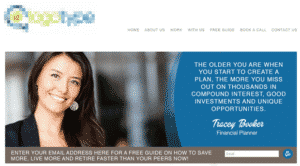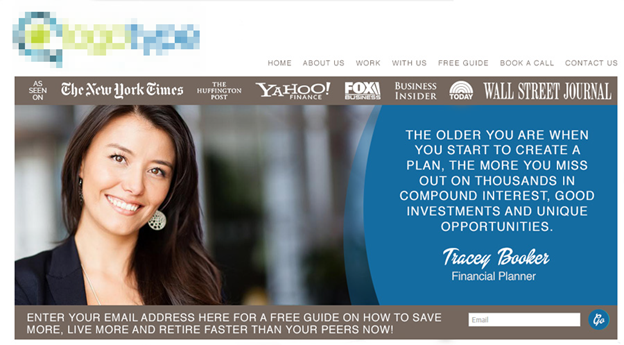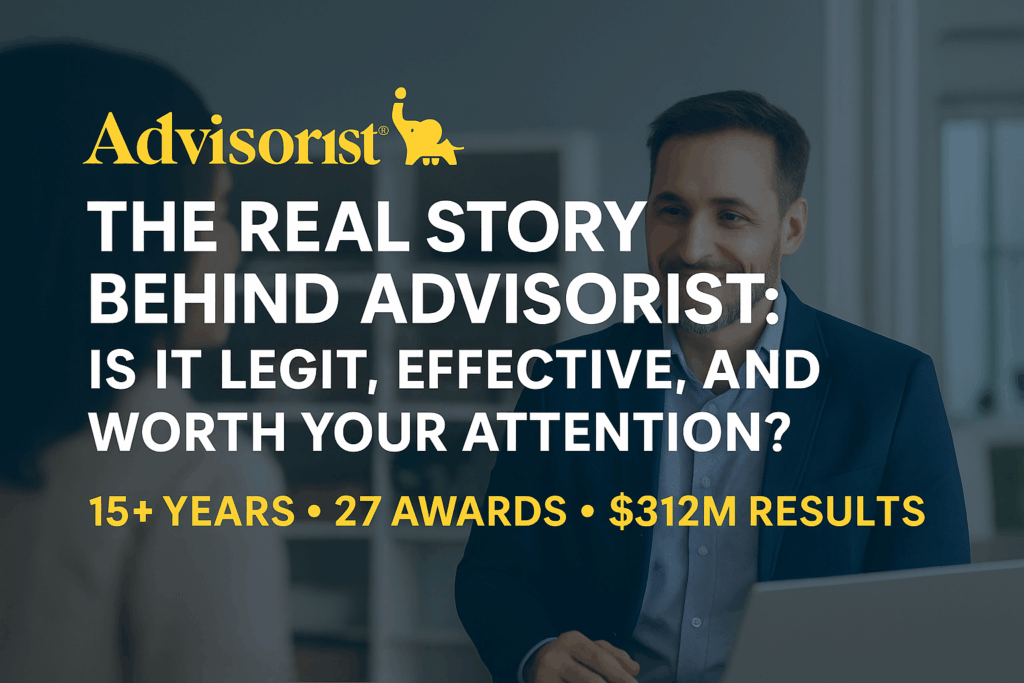Try not to become a person of success, but try to become a person of value.
—Albert Einstein
We work in one of the most regulated industries on the planet. Because of all the oversight, it can be very difficult to stand out. As a result, there’s a bit of an identity crisis going on in the insurance world.
The Pershing Institute did a study in which they interviewed the top investors, as identified by Fortune magazine. Then, they reviewed the top advisors serving that level of investor.
The study found that consumers want an advisor who:
- Tailors their solutions to meet individual needs.
- Works in their best interest.
- Has experience.
Why Your Prospects think you’re the same as the Other Guy
The good news is that the leading financial advisors Pershing studied were indeed highlighting similar value propositions on their websites.
Unfortunately, virtually all of the advisors highlighted these values … and little else.
This means that the only thing the advisors were telling their clients was that they “tailor their solutions,” “work in their clients’ best interest,” and are “experienced investment managers.”
They thought they were setting themselves apart.
But really, they all still looked the same!
Here’s the really crushing part.
According to the study, 60 percent—more than half—of all investors cannot distinguish among advisors at all!
That’s a shame.
Because if you’re reading this book, you are one of a special breed of advisors and agents who really feels that you have something unique to offer. You’re reading this book to learn specific strategies and techniques that will help separate you from every other agent out there.
Which brings us to the question:
How can you position yourself as a market authority and dramatically improve your results, sales, and deal flow?
Brand Exposure Leads to Brand Trust and Allegiance
To really understand the situation, I want to share a bit of neuroscience with you.
Back in 2002, a study showed that the more attention a product receives, the more likely consumers will be to choose it. This is VERY important to understand if you’re going to make the SHIFT to become a desired authority in your field.
Traditionally, the way companies approach this is by raising a large budget and doing lots of marketing, so that they are seen most often and remembered best.
That’s what billion-dollar companies such as Coca-Cola, Pepsi, Apple, and Nike do every day. They figure that the more you and I see LeBron James, Serena Williams, or Brett Favre with a product, the more likely we will be to choose that product.

These companies don’t have to deliver value in their ads. Their ads don’t have to lead directly to a conversation or a sale. They know you’re going to see their ad 10+ times over the course of a month and they trust that this repetition will lead you to buy their product.
It works.
Brand Exposure Makes a Brand Seem Better Than It Is
But another interesting study done in 1998 and again in 2000 examined something neuroscientists call “processing fluency.” (Reber et al, 1998, Winkielman et al, 2000)
Processing fluency is a science that suggests that items that come to mind more quickly will be liked better and will appear to be of higher value.
So, your product doesn’t necessarily have to be of a higher value—people just have to think it is. And they will, if it a) remains top-of-mind; or b) is associated with media, logos, brands, or people that ALREADY HAVE authority or value in their minds.
How to Use This Data With No Marketing Budget At All
That’s good news for those of us with a small budget. It means we just have to associate ourselves with brands that people already love, leverage those brands to attract consumer attention, and use those brands in our marketing.
Add One Little Line to Your Business Card
Let me give you an example of how this can be done.
You’re probably a member of one or several trade associations. Picture your business card. Wouldn’t it have more impact with one of those association logos on it (with permission, naturally)?
Of course it would.
Now, imagine this on your card: “As seen on CNN.com.”
Can you see how that would boost not only your confidence, but also your potential clients’ confidence in you? It would probably send both through the roof.
Actually, I know it would, because I measured it. I personally ran a test where I included my major media citations on my LinkedIn profile—right on my picture. I included that I was cited on CNN (which I was).
In less than 30 days, there was a 314 percent increase in the number of people who clicked on my profile—just because of that little logo.

Add a Big Brand Logo, Change Everything

This is Terry.
Terry is a hardworking agent based in California.
He recently saved a small town more than $26,000 in benefit costs with his creative strategies. Do you think Terry is worth $500 an hour?
Ninety percent of people will say no—just based on his picture.
Now, let me show you a different image.

This is the same Terry who saved a small town $26,000 in benefit costs.
And he’s been mentioned on CNN.
Is this agent worth $500 an hour?
Whenever I pose this question to a roomful of people, 80 percent inevitably change their mind right then and there. They give him a raise out of thin air!
All we did was make one small change to his photo.
Your Prospects Are Hard-Wired to Recognize Major Brands
Imagine for a moment how many billions of impressions have been made on your mind since childhood.
In a university study called “Too Young to Read, Old Enough to Shop,” logos for McDonald’s, Disney, and Toyota were shown to children aged 3-5 who couldn’t yet read.
They immediately knew what each one was.
They knew that McDonald’s was fast food, Disney was Mickey Mouse, and Toyota was cars.
If branding has that much impact on the mind of a 5-year-old, can you imagine how much it affects you?
That’s why, when you saw Terry’s photo attached to a small, familiar logo just a few centimeters wide, you immediately changed your opinion about him. The visual cortex of your brain shuffled through your memories and decided whether you trusted him.
When that logo was there, you trusted him more because you’ve learned to trust the logo.
When a financial advisor client of mine used these brands on her seminar invites, her attendees soared 128 percent over previous campaigns!
How to Tweak Your Website to Convert More Leads
Your goal is to turn as much of your traffic into leads as possible, right? So why not use this technique on your own website?
Let’s do an experiment.
Look at this simple website. It’s for Tracey Booker, a 31 year old financial planner that does fee-based financial planning.
Just based on the layout, would you pay her $2500 for a comprehensive financial plan?

When I ask this question in my talks, most people say ‘No’.
But now look at the same website and let me make a slight adjustment… (see if you can pick it up)

Now, let me ask you the same question: Just based on the layout, would you pay her $2500 for a comprehensive financial plan?
In most rooms, about 80% of the audience turns around and says ‘Yes’.
You feel more confident about her expertise this time, right? Yet, the design of the site didn’t change at all. The ONLY change was adding their media citations.
Now, The Real Stuff: How to Get Featured in the Media
So how can you go about getting yourself featured in media in the first place?
Help A Reporter Out (HARO)
First, sign up for Help a Reporter Out (helpareporter.com).
HARO is a global network of tens of thousands of reporters looking for sources every single day. When they’re working on a story, HARO is one of the first places they go.
HARO’s email newsletter goes out to hundreds of thousands of people. It contains all of the top stories being covered and reporters looking for sources.
You can help them out with stories about life insurance, annuities, financial services, etc. All you need is a great angle and a great pitch.
The Early Morning TV Show Pitch
Another ninja strategy is to call television stations in your area around 4 a.m. Ask to speak to a producer and offer to come on as a guest to talk about some local trends.
Be sure that when you call with your pitch, you tie your story in with actual trends.
But what stories are “hot”? You can find out by searching Google for trends in your industry. Trade publications are another great source of trends. As you pitch, mention the trend, then mention how you can provide advice on it.
Hire a Consultant—But Be Careful
Or, you can hire somebody to do it for you. Over on Elance.com, you can hire a public relations consultant on retainer for anywhere from $2,500 to $10,000 a month.
Now, here’s a shameless plug 😉
I’ve personally gone through the media wheelhouse many, many times. In seven years, I spent well over half a million dollars on media buying.
Unfortunately, not a single one of the media or PR consultants I hired was able to get me on television. This was a huge disappointment not only to me, but to my clients.
So, I went out and started my own boutique PR consulting firm, where clients pay only when they get coverage.
So far, we’ve placed more than 237 agents, financial advisors, professionals, lawyers, and doctors in such prestigious outlets as Forbes, Fortune, Oprah Winfrey, Dr. Phil, Dr. Oz, Rachel Ray, Bloomberg, CNN Financial, HGTV, Conan O’Brien, over 50 local news stations, and all the regional news stations.
We’ve gotten clients cited in prestigious digital publications such as the Huffington Post, Business Insider, Forbes.com, CNN.com, and many more.
If you would like more media exposure on a pay-for-performance basis, just contact my office.
We now return you to your regularly scheduled article reading… 😉
Summary
Overwhelming scientific and real-world evidence suggests that people make decisions on your value as an advisor or agent based on how FAST they can associate you with something they like.
If you don’t have a large marketing or PR budget, the best way to take advantage of that fact is to leverage brands or media outlets that your clients already value. By doing so, you gain “instant authority” in their minds.
The Takeaway
- Add any association logos you have permission to use to your profile picture, website, and business card.
- Use Helpareporter.com to contact journalists looking for sources; pitch a timely story to your local TV news station; or hire a consultant to help you get media placements.
- Anytime you’re covered in the media, add that information to your LinkedIn profile.
- Include your most prestigious citations as small logos on your photo.
- Use that photo on LinkedIn, Facebook, and anywhere your prospects might see you.



